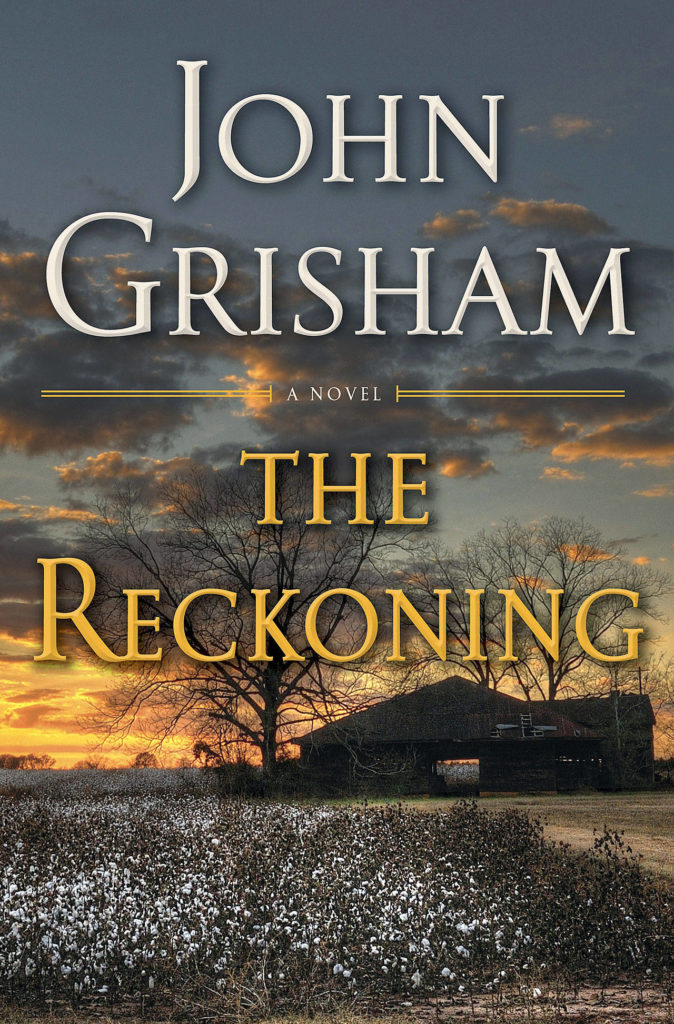By Neely Tucker / The Washington Post
In his new novel “The Reckoning” John Grisham returns to the mythical town of Clanton, Mississippi, the setting of his career-launching novel “A Time to Kill,” published 30 years ago. He’s revisited this racially divided community several times — in “The Last Juror,” “Sycamore Row” and the short-story collection, “Ford County.” Each takes place in a different time period.
“The Reckoning” is set in 1946, when World War II hero Pete Banning returns home a changed man, packing his wife off to an insane asylum and the shooting the town’s popular Methodist minister, refusing to explain either action.
Against this backdrop, Grisham continues the rich literary tradition of Southern authors confronting a culture of white supremacy and its offspring: corruption, violence and a general cultural miasma.
For American authors in general, and Southern ones in particular, Mississippi often functions as the nation’s heart of racial darkness. It’s regarded as “the most Southern place on earth” not because of its manners, moonlight or magnolias, but because of its malignant heart.
“Northerners, provincials that they are, regard the South as one large Mississippi,” the historian V.O. Key Jr. once wrote. “Southerners, with their eye for distinction, place Mississippi in a class by itself.”
The state’s white ruling class created this reputation by shaping itself into a minority-rule, terrorist regime after the Civil War, the shadows of which it still has not escaped. (I say this as a seventh-generation white Mississippian, whose ancestors include at least one slave-owner, a handful of hill-country rednecks and a Confederate soldier who lost a leg at Gettysburg.)
Writers such as Richard Wright, William Faulkner, Eudora Welty and Tennessee Williams founded the state’s outsize literary reputation, largely by writing about the quirks and horrors of Southern culture, most principally its racism. The state’s dazzling constellation of current writers — Jesmyn Ward, Natasha Trethewey, Donna Tartt, Richard Ford, Ellen Gilchrist, Greg Iles, Angie Thomas, Michael Farris Smith and so on — deal with the race question in ways small or large, in one genre or another, for to ignore race in Mississippi is to write about Arizona and ignore the desert.
The effect these writers have had on American letters is hard to overstate. Mississippians — born in one of the poorest, least educated states in America — have won nine Pulitzer Prizes for literature or theater, six National Book Awards, two Presidential Medals of Freedom, the Nobel Prize in literature, and served as the poet laureate of the United States.
John Grisham was born in Arkansas but mostly grew up in north Mississippi, and was a lawyer and state legislator there. He lived a couple of miles from Faulkner’s house in Oxford before decamping, as did Faulkner, to spend most of his time around Charlottesville. (Full disclosure, I wrote a short profile of Grisham in the early ’90s that he was not fond of.)
Grisham’s forte of course is the legal thriller, not thick-cut literary Southern Gothic, but he has often drawn on the state’s racist framework for plot and character development.
It was center stage in “A Time to Kill,” for example, and essential to “Sycamore Row.” In “Reckoning,” racial tensions subtly define the narrative.
After Banning shoots the minister, gives himself up to arrest but refuses to explain himself, the town begins to suspect that there might not be enough mental cotton in his gin.
“This family needs a full-time lawyer,” Joel, his college-age son says early on, and you just know a Grisham-esque attorney is coming to the rescue.
That doesn’t quite happen, although there are a couple of trials that bookend a segment of Pete’s harrowing war experiences. As the why-he-dunnit unwinds, the plot wades into a tangle of white and black family relationships, coming to rest in moral waters as muddy as the river that gives the place its name.
This is complicated by the fact that Pete Banning is one of the “good” white people of the day. He provides a school for the black children of workers on his 640-acre cotton-farming spread and is kind to the help.
But the slavery and white supremacy that has shaped Banning’s world is not something that he contemplates, nor is the way his family built its wealth by exploiting black labor.
Liza, his city-born wife and new to the neo-plantation, once rides out to the woods where the field hands live in abject squalor. She is appalled.
Later, when an attorney seeks to claim the Banning estate as civil damages for the slaying of the pastor, he finishes the inventory of land and housing with:
“They have half a dozen outbuildings, fine structures all, plus the farm equipment, and livestock, and how many Negroes?”
“Please, Burch, they don’t own those people,” the Banning attorney says.
“For all practical purposes they do,” the lawyer snaps back.
This is an accurate portrait of Mississippi in the 1940s, and it illuminates one of the difficulties in writing about the era today. The Banning family’s casual arrogance in assuming that they are “good” whites to their poverty-stricken black employees can grate on the modern reader’s nerves, as can the irony-free, subservient attitudes their most trusted servants display.
The Bannings are “the only white people” who Nineva, the elderly house maid, trusts. Her gardener husband, Amos, “adored” Liza at first glance, thinking her “the most beautiful woman he’d ever seen.” The couple have four children and “a yard full of grandchildren.” Their teenage grandson, Jupe, is a “strapping, muscular boy who was fascinated by Liza but terribly shy around her.”
Small wonder. Good white men in Mississippi of that era had no hesitation killing black teens who were fresh with white women and juries composed of other good white men had no hesitation in acquitting them for it. (See: Till, Emmett.)
It may be, if Grisham is being cleverly subversive, that both the title and the denouement of “The Reckoning” addresses the state’s racial mores with a wicked, devastating twist. Maybe, in the end, there really is a rough-hewed justice at work, even in 1940s Mississippi.
“The Reckoning”
By John Grisham
Doubleday. 420 pages. $29.95.
Talk to us
> Give us your news tips.
> Send us a letter to the editor.
> More Herald contact information.



























